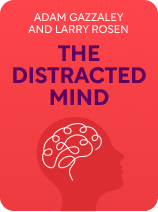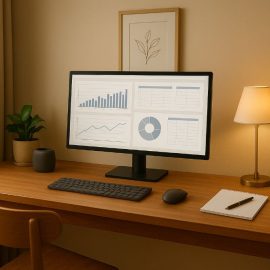

This article is an excerpt from the Shortform book guide to "The Distracted Mind" by Adam Gazzaley and Larry Rosen. Shortform has the world's best summaries and analyses of books you should be reading.
Like this article? Sign up for a free trial here.
What are the dangers of technology people face today? How does technology interfere with education and work?
In The Distracted Mind, Adam Gazzaley and Larry D. Rosen discuss the impact of increased technological interference. Technological interference does widespread harm in various domains of life, including school, the workplace, and our relationships.
Discover more about the dangers of technology and how they get in the way of everyday aspects of life.
Impact #1: Interference in Education
First, Gazzaley and Rosen write that one of the dangers of technology is the widespread interference both in and out of the classroom. According to studies cited by Gazzaley and Rosen, about 90% of college students report using their phones to text while in class—a clear case of interruption (intentional decisions to pursue secondary goals). Moreover, the authors point out that the results are similar outside the classroom: In one study, researchers examined students’ behavior during three-hour study sessions, finding that students checked their phones an average of nine times during these sessions, spending about 30 minutes off task.
(Shortform note: For further context, it bears mentioning that this widespread smartphone use is occurring even though in-class cellphone use is widely banned—the National Center for Education Statistics reports that, in 2020, 77% of public schools had banned nonacademic cellphone use in the classroom. In college classrooms, the picture is further complicated by the fact that many students use their laptops in class, even though researchers have found that increased in-class laptop use is predictive of poorer academic performance.)
According to Gazzaley and Rosen, this technological interference decreases students’ productivity and efficiency. They point out that researchers have found that nearly all forms of in-class technology usage are predictive of poorer classroom performance. Moreover, the authors note that researchers have made similar findings for out-of-class technology usage; for instance, one study found that students who paused to send instant messages while completing an assignment took consistently more time than peers who didn’t (even when accounting for the extra time spent messaging).
(Shortform note: Technology-induced interference also became more common in the wake of the Covid-19 pandemic, which compelled students across the country to learn remotely via computers. One study found that students in remote classes demonstrated more frequent mind-wandering (shifting their attention from their primary task to unrelated internal thoughts)—a clear form of internal interference.)
Impact #2: Interference in the Workplace
In a similar vein, Gazzaley and Rosen argue that technological interference has also infiltrated the workplace. They cite a study wherein researchers observed office workers for two weeks and found that these workers were interrupted over four times per hour by email and three times per hour by instant messaging. Crucially, 40% of these workers immediately dropped their tasks to respond to emails, while 70% did so to reply to instant messages.
(Shortform note: Though technology is ubiquitous in the modern workplace, some experts note that certain forms of technology benefit workers. For example, they point out that noise-canceling headphones actually decrease external distractions, leading to improved worker concentration and performance. Additionally, video conferencing technology enables face-to-face communication with workers from around the world, which can foster a sense of connection in an increasingly remote workplace.)
Gazzaley and Rosen argue that workplace interference increases workers’ stress and decreases their efficiency. To show as much, they cite a study of over 200 employees that measured the most significant predictors of employees’ stress levels—behind workload, external interruptions were the greatest predictor of stress levels. Further, as for worker efficiency, Gazzaley and Rosen point to studies showing that workers often take around a half-hour to reorient themselves to their initial task following an interruption or distraction.
(Shortform note: Not only does workplace interference increase workers’ stress, but in high-stakes work environments, it can also be deadly. One study found that almost half of all aviation accidents occur because of external interruptions that distract pilots. Similarly, researchers have found that emergency room doctors are regularly subject to external interruptions, which can compromise the quality of patient care.)
Impact #3: Interference in Relationships
Finally, Gazzaley and Rosen write that technological interference has a corrosive effect on human relationships because it inhibits connection. For instance, it’s common to complain that friends are on their phones at dinner rather than conversing with each other. Moreover, the authors note that empirical studies have verified the adverse effects that technology has on relationships. One study found that when two strangers conversed for the first time, they reported feeling significantly less empathy and connection toward each other when a smartphone was lying on a table nearby; this has been referred to as “the iPhone Effect.”
| Smartphone Use in Romantic Relationships: Effects and Remedies In a similar vein, research has confirmed that smartphone use often has a detrimental impact on romantic relationships in particular. One study of 145 married adults found that “phubbing”—using your phone as a means of ignoring your partner—was predictive of decreased marital satisfaction, even though it occurs in around 70% of romantic relationships. Nonetheless, other experts contend that we can take steps to mitigate the harmful effects of smartphones in our romantic relationships. For example, they recommend setting aside “device-free” time with one another, in which you both turn off your devices to focus entirely on each other. Moreover, they recommend embracing the advice laid out by John Gottman and Nan Silver in The Seven Principles for Making Marriage Work—namely, responding positively to your partner’s bids for connection, rather than using your phone to retreat from the conversation. |

———End of Preview———
Like what you just read? Read the rest of the world's best book summary and analysis of Adam Gazzaley and Larry Rosen's "The Distracted Mind" at Shortform.
Here's what you'll find in our full The Distracted Mind summary:
- How technology has made us more prone to distractions and interruptions
- How to modify your environment to reduce distractions and boredom
- How to minimize your susceptibility to interference and improve cognitive control






